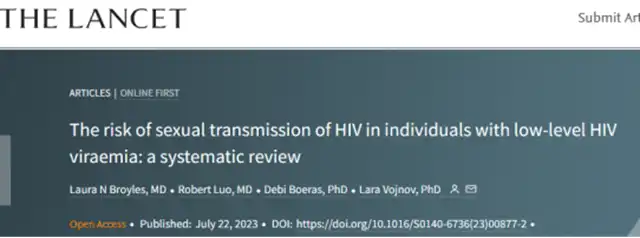Low Viral Load in HIV-Positive Individuals Does Not Transmit the Virus to Sexual Partners
- Normal Liver Cells Found to Promote Cancer Metastasis to the Liver
- Nearly 80% Complete Remission: Breakthrough in ADC Anti-Tumor Treatment
- Vaccination Against Common Diseases May Prevent Dementia!
- New Alzheimer’s Disease (AD) Diagnosis and Staging Criteria
- Breakthrough in Alzheimer’s Disease: New Nasal Spray Halts Cognitive Decline by Targeting Toxic Protein
- Can the Tap Water at the Paris Olympics be Drunk Directly?
Low Viral Load in HIV-Positive Individuals Does Not Transmit the Virus to Sexual Partners
- Should China be held legally responsible for the US’s $18 trillion COVID losses?
- CT Radiation Exposure Linked to Blood Cancer in Children and Adolescents
- FDA has mandated a top-level black box warning for all marketed CAR-T therapies
- Can people with high blood pressure eat peanuts?
- What is the difference between dopamine and dobutamine?
- How long can the patient live after heart stent surgery?
Low Viral Load in HIV-Positive Individuals Does Not Transmit the Virus to Sexual Partners
In individuals with HIV infection and low viral loads, the virus is unlikely to be transmitted to sexual partners!
Currently, antiretroviral therapy (ART) effectively suppresses HIV replication, controls viral load, and improves the quality of life for people living with HIV.
Therefore, viral load is considered the “gold standard” for assessing the effectiveness of antiretroviral treatment.
Based on past experiences, it has been widely believed that individuals with HIV, following standardized antiretroviral treatment, are considered “non-infectious” when their viral load is below 200 copies/ml.
However, there has been ongoing debate regarding the transmission risk when the viral load is between 200 and 1000 copies/ml.
A systematic review published in The Lancet on July 22, 2023, compiled research evidence indicating that when the HIV viral load is less than 600 copies/ml, there is no evidence of HIV transmission.
In cases where the viral load is between 600 and 1000 copies/ml, instances of HIV transmission are extremely rare. When the viral load is less than 1000 copies/ml, the probability of sexual transmission without using a condom is minimal, approximately 0.028%.

I. Relevant Studies
Researchers examined studies on HIV sexual transmission under different viral load conditions from 2010 to 2022. Eight studies, involving 7762 serodiscordant couples (where one partner is HIV-positive and the other is HIV-negative) from 25 countries, were included. Three studies demonstrated that as long as individuals with HIV adhere to antiretroviral treatment and maintain a viral load below 1000 copies/ml, the risk of sexual transmission is nearly zero.
The transmission risk was further categorized as follows:
1. No HIV transmission when the viral load is below 200 copies/ml.
2. No clear evidence of HIV transmission when the viral load is below 600 copies/ml.
3. Very low likelihood of HIV transmission when the viral load is between 600 and 1000 copies/ml.
It is important to note two points: firstly, the information and results mentioned above do not apply to mother-to-child transmission of HIV, as the exposure time and intensity during pregnancy, childbirth, or breastfeeding are much higher than in sexual encounters. Secondly, when the viral load exceeds 1000 copies/ml, indicating significant viral replication, the risk of HIV transmission increases!
II. Key Insights
This study reinforces the idea that individuals with HIV who adhere to antiretroviral treatment and maintain a low viral load have almost zero risk of sexual transmission, providing strong support for the global “undetectable equals untransmittable” (U=U) movement. The study also offers important insights:
1. Although HIV cannot be cured, early detection, knowledge of infection status, and standardized antiretroviral treatment can prolong life and improve quality of life.
2. Untreated or inadequately treated sexual partners are the primary sources of HIV sexual transmission. It is recommended that every person living with HIV actively undergo treatment to reduce the risk of sexual transmission.
3. Regular viral load testing is crucial. Recommendations include testing around the 4th week of initial treatment, followed by testing every 3 months until viral load is completely suppressed. Within the first 2 years of treatment, testing every 3-4 months is advised, and after 2 years of stable viral load suppression, testing every 6 months is recommended. For untreated individuals with HIV, annual viral load testing is suggested.
Summary:
Discovering HIV positivity and promptly undergoing antiretroviral treatment can effectively suppress HIV replication, reduce viral load to undetectable levels, maintain immune function, lower the incidence of HIV-related diseases and mortality, and promote health and longevity. Importantly, individuals with well-controlled HIV, achieving undetectable viral loads, do not transmit HIV to sexual partners through sexual transmission.
Therefore, individuals with HIV should actively pursue antiretroviral treatment, consider undetectable viral load as a treatment goal (aiming to control viral load below 50 copies/ml), and achieve viral suppression as early as possible. This approach helps reduce the risk of developing drug resistance and low-level viremia, improving overall health and enhancing quality of life.
Low Viral Load in HIV-Positive Individuals Does Not Transmit the Virus to Sexual Partners
(source:internet, reference only)
Disclaimer of medicaltrend.org
Important Note: The information provided is for informational purposes only and should not be considered as medical advice.



